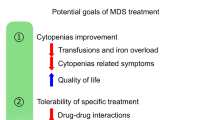Abstract
We report a retrospective analysis of 38 patients (age ≤ 30 years) who underwent allogeneic hematopoietic stem cell transplantation (allo-SCT) for relapsed or refractory anaplastic large-cell lymphoma (ALCL). Median follow-up for survivors after undergoing allo-SCT was 72 months (range, 35–96 months). Eight patients received reduced-intensity conditioning (RIC) regimens, including three patients with fludarabine plus melphalan-based regimens and five patients with fludarabine plus busulfan-based regimens. The remaining 30 patients received myeloablative conditioning (MAC) regimens. Median ages in the RIC and MAC groups were 24 and 15 years, respectively. The 5-year overall survival rates in the RIC and MAC groups were 100% and 49%, respectively (P = 0.018). The 5-year event-free survival rates in the RIC and MAC groups were 88% and 43%, respectively (P = 0.039). In the RIC group, four of the eight patients showed residual disease at allo-SCT, but all eight patients survived with complete remission (CR), including one patient with relapse. This result suggests that allo-SCT using the RIC regimen may be effective for relapsed or refractory ALCL in children, adolescents, and young adults, even in non-CR cases.

Similar content being viewed by others
References
Fukano R, Mori T, Kobayashi R, Mitsui T, Fujita N, Iwasaki F, et al. Haematopoietic stem cell transplantation for relapsed or refractory anaplastic large cell lymphoma: a study of children and adolescents in Japan. Br J Haematol. 2015;168(4):557–63.
Yaniv I, Stein J, Party EPW. Reduced-intensity conditioning in children: a reappraisal in 2008. Bone Marrow Transplant. 2008;41(Suppl 2):S18–22.
Giralt S, Ballen K, Rizzo D, Bacigalupo A, Horowitz M, Pasquini M, et al. Reduced-intensity conditioning regimen workshop: defining the dose spectrum Report of a workshop convened by the center for international blood and marrow transplant research. Biol Blood Marrow Transplant. 2009;15(3):367–9.
Ohta H, Kusuki S, Yoshida H, Sato E, Hashii Y, Ozono K. Allogeneic hematopoietic stem cell transplantation with reduced intensity conditioning for a child with recurrent anaplastic large cell lymphoma. Int J Hematol. 2010;92(1):190–3.
Luger SM, Ringden O, Zhang MJ, Perez WS, Bishop MR, Bornhauser M, et al. Similar outcomes using myeloablative vs reduced-intensity allogeneic transplant preparative regimens for AML or MDS. Bone Marrow Transplant. 2012;47(2):203–11.
Bacigalupo A. Third EBMT/AMGEN Workshop on reduced-intensity conditioning allogeneic haemopoietic stem cell transplants (RIC-HSCT), and panel consensus. Bone Marrow Transplant. 2004;33(7):691–6.
Bacigalupo A, Ballen K, Rizzo D, Giralt S, Lazarus H, Ho V, et al. Defining the intensity of conditioning regimens: working definitions. Biol Blood Marrow Transplant. 2009;15(12):1628–33.
Strullu M, Thomas C, Le Deley MC, Chevance A, Kanold J, Bertrand Y, et al. Hematopoietic stem cell transplantation in relapsed ALK + anaplastic large cell lymphoma in children and adolescents: a study on behalf of the SFCE and SFGM-TC. Bone Marrow Transplant. 2015;50(6):795–801.
Crocchiolo R, Esterni B, Castagna L, Furst S, El-Cheikh J, Devillier R, et al. Two days of antithymocyte globulin are associated with a reduced incidence of acute and chronic graft-versus-host disease in reduced-intensity conditioning transplantation for hematologic diseases. Cancer. 2013;119(5):986–92.
Russell JA, Turner AR, Larratt L, Chaudhry A, Morris D, Brown C, et al. Adult recipients of matched related donor blood cell transplants given myeloablative regimens including pretransplant antithymocyte globulin have lower mortality related to graft-versus-host disease: a matched pair analysis. Biol Blood Marrow Transplant. 2007;13(3):299–306.
Devillier R, Furst S, El-Cheikh J, Castagna L, Harbi S, Granata A, et al. Antithymocyte globulin in reduced-intensity conditioning regimen allows a high disease-free survival exempt of long-term chronic graft-versus-host disease. Biol Blood Marrow Transplant. 2014;20(3):370–4.
Corradini P, Dodero A, Zallio F, Caracciolo D, Casini M, Bregni M, et al. Graft-versus-lymphoma effect in relapsed peripheral T-cell non-Hodgkin’s lymphomas after reduced-intensity conditioning followed by allogeneic transplantation of hematopoietic cells. J Clin Oncol. 2004;22(11):2172–6.
Woessmann W, Zimmermann M, Lenhard M, Burkhardt B, Rossig C, Kremens B, et al. Relapsed or refractory anaplastic large-cell lymphoma in children and adolescents after Berlin-Frankfurt-Muenster (BFM)-type first-line therapy: a BFM-group study. J Clin Oncol. 2011;29(22):3065–71.
Acknowledgements
We wish to thank each of the clinicians, hospital administrators, and health center administrators who provided precise data via the registry of the Japan Society for Stem Cell Transplantation. We also wish to thank Yuki Yamashita for supporting the data analysis.
Author information
Authors and Affiliations
Contributions
NF, TM, RK, TM, KK, RS, JS, and RF designed the research study; TF, MS, NM, TS, KO, MI, JI, YK, JI, YH, AS, and KT collected the data; RS and RF analyzed the data; and RF wrote the paper. All authors reviewed the manuscript.
Corresponding author
Ethics declarations
Conflict of interest
R. Suzuki reports personal fees from Bristol-Meyer Squib, Novartis Pharmaceuticals, Kyowa-Hakko Kirin, Chugai Pharmaceutical, Shionogi, Takeda Pharmaceutical, Meiji Seika Pharma, MSD, Otsuka Pharmaceutical, Sawai, Celgene, Sumitomo Dainippon Pharma, Eisai Pharmaceuticals, Alexion Pharma, Sano, Gilead Sciences, Abbvie Inc., Mundi Pharma, Jazz Pharma, Ono Pharmaceutical, and Janssen Pharmaceuticals, outside the submitted work. The other authors declare no relevant conflict of interest.
Additional information
Publisher's Note
Springer Nature remains neutral with regard to jurisdictional claims in published maps and institutional affiliations.
About this article
Cite this article
Fukano, R., Mori, T., Fujita, N. et al. Successful outcome with reduced-intensity condition regimen followed by allogeneic hematopoietic stem cell transplantation for relapsed or refractory anaplastic large-cell lymphoma. Int J Hematol 110, 723–728 (2019). https://doi.org/10.1007/s12185-019-02748-1
Received:
Revised:
Accepted:
Published:
Issue Date:
DOI: https://doi.org/10.1007/s12185-019-02748-1




